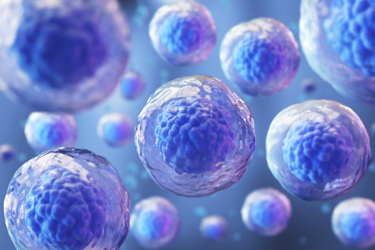Universalizing Allogeneic Cell Therapies With Cord-Blood-Derived Stem Cells

By Tyler Menichiello, Chief Editor, Bioprocess Online

In August, Coeptis Therapeutics licensed an allogeneic stem cell expansion and differentiation platform from Deverra Therapeutics, as well as two Phase 1 NK-cell assets. This acquisition transformed Coeptis into a clinical-stage company and marks their first step into the allogeneic cell therapy space. Along with these assets came Coeptis’ newly appointed chief scientific and medical officer, Dr. Colleen Delaney, who invented the platform.
At the heart of Delaney’s platform are stem cells sourced from umbilical cord blood, which she believes is the best source of starting material for allogeneic cell therapies. I met with Delaney, as well as Coeptis’ CEO and COO, Dave Mehalick and Dan Yerace, to discuss the exciting potential of cord-blood-derived stem cells — why they make for a great starting material and how this can drive down the cost of cell therapies.
A “Beautiful” Source Of Starting Material



There are essentially three main sources of starting material for allogeneic therapies: healthy adult donors, induced pluripotent stem cells (iPSC), and cord blood. According to Delaney, the problem with the first two sources is the extensive amount of screening and cellular reprogramming required to make them a viable source of starting material.
“Harvesting cells from healthy adult donors is very expensive and difficult because of the screening requirements to qualify the donor and their cells as starting material,” she says. These cells need to be checked for multiple infectious disease markers before the manufacturing process can even begin.
As for iPSCs, generating a clinical-grade cell line is complex — it takes a lot of genetic reprogramming to revert these cells to their pluripotent stage. According to Delaney, there are also a number of safety concerns around using highly genetically modified starting materials. She says patients who receive these types of heavily modified cells need to be followed for up to 15 years.
Many of these regulatory hurdles and bottlenecks don’t apply to cord blood, which is why Delaney considers it a “beautiful” source of starting material. “Cord blood is the youngest, healthiest, fully regulated source of cells,” she says. These cells come from a very immune-privileged environment in the placenta, meaning there is an exceedingly low risk of transmissible infections that are commonly found in healthy adult donors. Additionally, in the U.S., the FDA requires public banks to store cord blood under a BLA.
Because of this BLA, cord blood doesn’t have to undergo the same rigorous screening and regulatory hurdles as iPSCs or adult donors. Delaney says the infrastructure provided by these banks with consenting, screening, and storing donors under BLA makes cord blood a highly regulated source of starting material. Not only that, but over 800,000 units of cord blood are stored in banks worldwide, so “you’re never not going to have a supply of cord blood,” she explains. “It’s medical waste. This is stuff that’s thrown away every single day, so the supply chain is always going to be there.”
Reducing The Cost Of Cell Therapies
Allogeneic therapies, especially those generated from single cell lines (i.e. from single donors or iPSCs) can only be dosed a certain number of times before a patient’s immune system becomes allosensitized or immune to the therapy. “We know that when you give an allogeneic cell therapy, it will eventually be rejected by the host,” Delaney explains. “Host immune-mediated rejection is an issue for any allogeneic or even genetically modified autologous product. But, if we can develop cellular immunotherapy products cost effectively with enhanced in vivo persistence, multi-dosing strategies are a realistic approach.”
Delaney believes one way to reduce allosensitization is by pooling cord blood prior to stem cell expansion and differentiation. “By pooling donors, we’re always going to have products that can be given to patients repeatedly and not have them be recognized immediately by the immune system, potentially enhancing in vivo persistence prior to rejection.”
Mature (educated) immune cells (e.g., T cells) from an unrelated donor need to be matched to patients on an allelic level to avoid graft-versus-host disease (GVHD). Unrelated donor NK cells, on the other hand, do not require matching and do not cause GVHD. However, because they are still allogeneic, these cells will eventually be rejected. Delaney explains how pooled donor manufacturing may overcome rapid rejection. “When I give this final product to a patient, there’s a chance that one of those donors in the pool may be a little more [Human Leukocyte Antigen] matched to the patient than the others, and that group of cells may actually end up persisting even longer.”
Coeptis currently has two INDs that allow it to do pool donor manufacturing. These INDs, combined with an abundant, readily available starting material, mean Coeptis can theoretically produce multiple doses at a fraction of the cost of autologous therapy. “Our approach really has been to fully recognize and accept that allogeneic cell therapies are going to require repeated dosing, so we need to generate therapies that can be done that way safely and cost effectively,” Delaney says.
Coeptis uses its “standardized and clinically utilized” stem cell expansion platform prior to cell differentiation to generate immune effector cells from pooled, cord-blood-derived CD34+ cells. “This platform and pooled donor manufacturing overcomes many of the hurdles facing the allogeneic cell therapy space today,” she explains. “It addresses scalability, donor to donor variability, cost of goods, and patient access.”
“We’re trying to universalize cell therapy, to get it to a place where it’s available to everyone,” Mehalick says. “Right now, it’s autologous, and it’s super expensive. This new platform allows us to generate these allogeneic cells at one-tenth of the cost — where it now moves to a frontline therapy, and that’s a world-changing event.”
